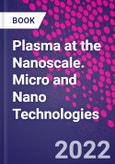Plasma technology can facilitate the fabrication of nanomaterials and nanoscale structures. On the other hand, nanotechnology could be possibly used in plasma science. Several advanced nanomaterials and nanodevices could be used to fabricate nanoplasma (nanoscale plasma), such as nanoelectrodes, nanoantennae, nanolasers, nanoreactors, nanomagnets, nanosensors, nanobatteries, nanogenerator and supercapacitors.
This book provides information on fundamental design concepts and promising applications of nanoplasma. It explains how, for the next generation of electronic devices with high data rate communications, a high-speed operation of electronic switches could be attained using nanoplasma. Similarly, in the field of heath and aesthetics, nanoplasma can be used as a non-surgical localized treatments for the face and neck, such as eyelid correction. In addition, various kinds of advanced nanostructures can be fabricated using the plasma technology
Please Note: This is an On Demand product, delivery may take up to 11 working days after payment has been received.
Table of Contents
Part 1: Basic Principles1. Nanoplasma in the context of plasma
2. Nanoplasma: Basic principles, fundamentals, and classification
3. Fundamentals of nanoplasma interaction with materials
4. Methods for generation of nanoplasmas
5. Magnetically confined plasmas at the nanoscale
6. Methods for characterization and evaluation of nanoplasma
7. Mathematical modeling of nanoplasma
8. Regulatory, toxicological and environmental issues of nanoplasma
Part 2: Applications
9. Potential applications of plasmas containing nanostructured species
10. Picosecond switches for ultrafast electronics
11. Potential applications of nanoplasma in biology and medicine
12. Aesthetics application (beauty care/nanocosmetics)
13. Nanoplasma for Oncotherapy
14. Nanoplasma for Sensing Application
15. Modern implantology (nanosurface, biocompative treatment.)
16. Sterilization/decontamination
17. Nanoplasma for Display panels for luxury mobile devices
18. Nanoplasma for Energy conversion and storage
19. Nanoplasma: Future perspectives








